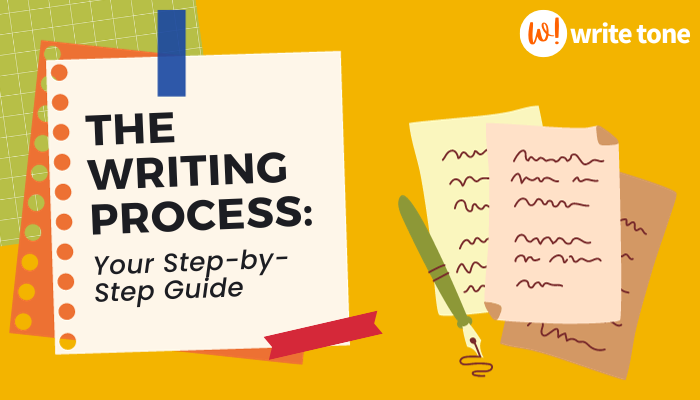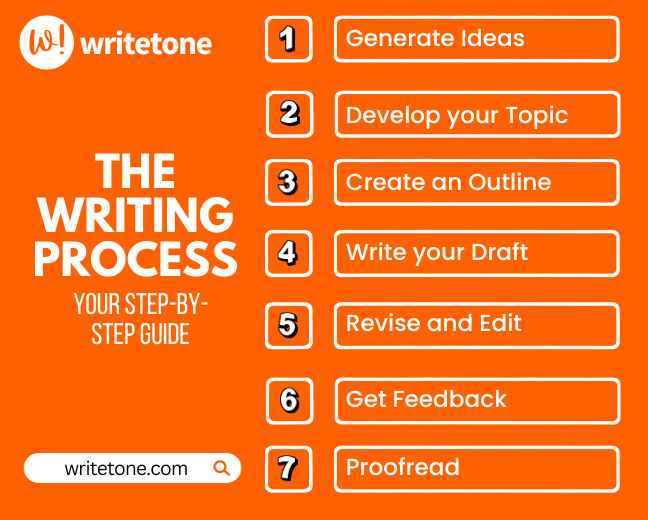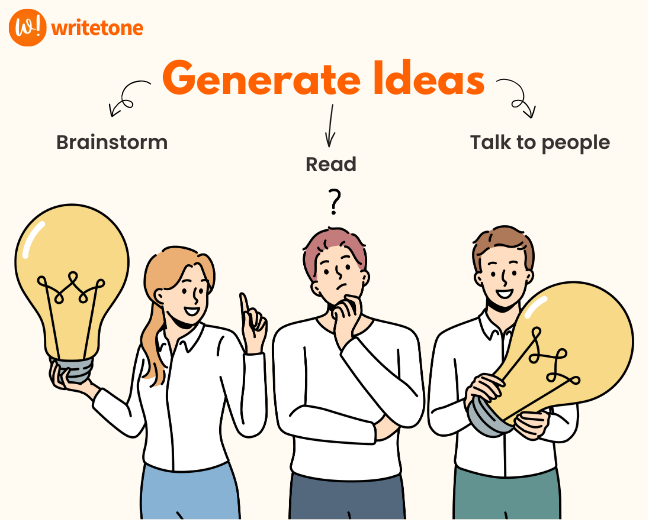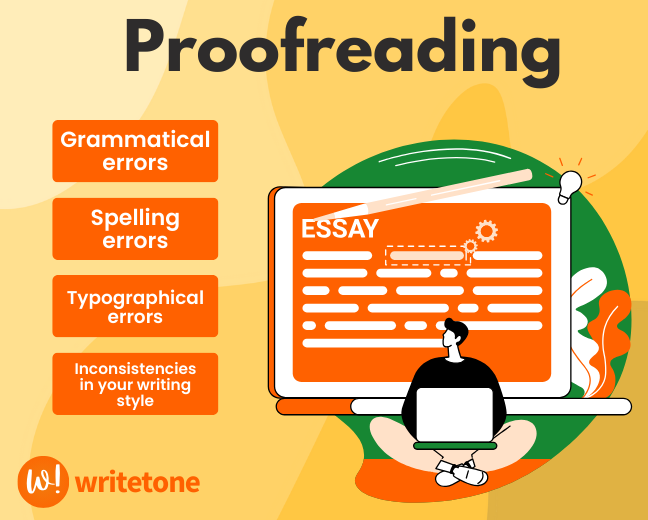The Writing Process: Your Step-by-Step Guide

Writing can be a daunting task, especially if you're not sure where to start. But the good news is that it doesn't have to be. There is a process that you can follow to make the writing process easier and more efficient.

In this blog post, we will demystify the writing process and provide you with a step-by-step guide on how to go from idea to a polished piece of writing.

Step 1: Generate Ideas
The first step in the writing process is to generate ideas. This can be a challenging step, but there are a few things you can do to make it easier:

•Brainstorm:
Write down any ideas that come to mind, no matter how crazy they seem. You can always refine your ideas later.
•Read:
Reading can help you to generate new ideas and learn about different writing styles.
•Talk to people:
Chatting with friends, family, and colleagues can also help you to come up with new ideas.
Step 2: Develop your Topic
Once you have a few ideas, it's time to choose one and develop it further. This involves researching your topic, narrowing down your focus, and developing a thesis statement.

•Research your topic:
Learn as much about it as you can. This means reading books, articles, and other sources on the topic. You can also talk to experts in the field or conduct your own research. You can also take help from AI tools like Writetone’s AI Tutor that ensures your content is factually accurate, industry-relevant, and well-written.
Writetone's AI Tutor suggests corrections that are relevant to your subject. It offers expertise in a variety of fields, including science, marketing, sales, finance, and human resources.
| Free AI AI Tutor
•Narrow down your focus:
Once you have a good understanding of your topic, it's time to narrow down your focus. This means deciding what specific aspect of the topic you want to write about.
•Develop a thesis statement:
The thesis statement is the main argument of your essay. It's a one sentence statement that states your position on the topic and what you intend to prove in your essay.
If you're writing about the importance of education, your thesis statement might be:
Education is essential for a just and prosperous society.Step 3: Create an Outline
An outline can help you to organize your thoughts and ensure that your essay has a clear structure. It doesn't have to be anything fancy, but it should include the main points of your essay and the order in which you will discuss them.
For examplelet's say you were writing an essay. Here is a basic outline:
- 1.Introduction
- 2.Body paragraphs
- 3.Conclusion
• Introduce your topic and thesis statement.
• Provide some background information on the topic.
• Each body paragraph should support your thesis statement with evidence from your research.
• Each body paragraph should be organized around a main idea.
• Summarize your main points.
• Restate your thesis statement.
Step 4: Write your Draft
Now it's time to start writing! Don't worry about making it perfect at this stage. Just get your thoughts down on paper (or screen). You can always go back and revise later.
When you're writing your draft, it's helpful to think about your audience and what you want to achieve with your essay. What do you want your reader to know or think after reading your essay? Once you have a clear idea of your purpose, you can start to develop your argument and organize your thoughts.
Use language that is clear and concise and avoid jargon or technical terms that your reader may not be familiar with. Also, be sure to support your arguments with evidence from your research.
Step 5: Revise and Edit
Once you have a draft, it's time to revise and edit it. This involves checking for grammar and spelling errors, improving your sentence structure, and making sure that your essay is clear and concise.
You can use AI tools, like Writetone, to help you with this. Use Writetone's AI-powered free online grammar checker to improve your English writing by checking for grammar, spelling, and punctuation errors.
Also, Writetone makes sure you use the right tone, words, and style for every situation. Writetone is designed to provide a variety of writing tones to assist you in writing effectively.
| Use Writetone now
Once you've revised your essay, it's time to edit it. This involves correcting any grammar and spelling errors, and making sure that your essay is consistent in style and tone.
Step 6: Get Feedback
Ask a friend, family member, or colleague to read your essay and give you feedback. This can help you to identify any areas that need improvement see your essay from a different perspective and identify any errors or inconsistencies that you may have missed.
When asking for feedback, it is important to be specific about what you are looking for
For example:You could ask your reader to focus on the following:
• The overall structure of your essay
• The clarity of your writing
• The use of evidence to support your claims
• The effectiveness of your arguments
Once you have received feedback, you should carefully consider it and make any necessary revisions. This will help you to improve the quality of your essay and make it more likely to be successful.
Step 7: Proofread
Before you finalize your content, it is important to proofread it carefully. This will help you to catch any errors that you missed during the revision and editing process. You should proofread for the following:

• Grammatical errors
• Spelling errors
• Typographical errors
• Inconsistencies in your writing style
Proofreading is an important step in the writing process. It can help you to make a good impression on your readers and ensure that your writing is errorfree.
How Writetone can help?
Writetone is an AI-powered writing tool assistant that can help you with all aspects of the writing process. It offers a variety of features, including:
Paraphrasing:
Writetone can help you to paraphrase your text without plagiarizing. This can be helpful if you're struggling to come up with your own words or if you need to make your writing more concise.
| Experience Writetone now
Summarizing:
Writetone can summarize your text for you. This can be helpful if you need to condense your essay into a shorter version or if you want to get a quick overview of a long essay.
| Summarize instantly with this AI tool
Grammar and spelling check:
Writetone can help you to identify and fix grammar and spelling errors in your writing.
| Fix your Grammar in just one click
AI Tutor:
Writetone AI powered SME feature ensures your content is factually accurate, industry-relevant, and well-written.
| Get free AI Tutor now
Text to voice:
Writetone can convert your essay to speech. This can be helpful if you want to listen to your essay before you submit it.
| Free Text to Speech Convertor
To use Writetone, simply copy and paste your text into the Writetone editor. Then, click on the button for the feature you want to use. Writetone will generate the results for you immediately.
Conclusion
Writing is a structured process, but that doesn't mean it can't be creative. In fact, the best writing often comes from writers who are able to use the structure to their advantage.
The key is to find a balance between structure and creativity. Too much structure can stifle creativity, but too much creativity can make it difficult to stay on track.
Writetone can help you find that balance. Our tools can help you with everything from paraphrasing and summarizing to grammar fixes and text-to-speech. So, if you're looking for a writing companion that can help you create amazing content, give Writetone a try today.